 |
 |
 |
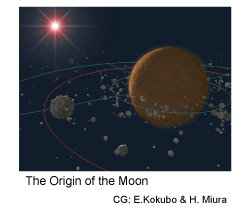

|
* Planetary Formation 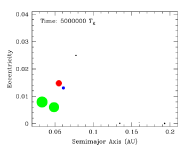 Planetary Formation around Class G and Class M Stars
Planetary Formation around Class G and Class M StarsTerrestrial Planet Formation using N-body simulation Asteroid Distribution in Main Belt The effects of tidal resistance and secular resonances on the evolution of the Asteroid Distribution in the Main Belt
Left Figure: an example of a result of proto planet formation around class M stars
using N-body simulation * Terrestrial Planets 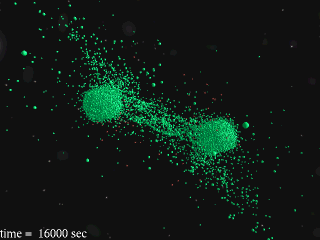 Thermal Evolution of Terrestrial Planets
Thermal Evolution of Terrestrial PlanetsSimulation of a time dependent heat transfer using a planetary interior model The mantle convection in the interior of Earth The origine of the water and atmosphere of Earth The capture of the water and atmosphere of Earth The capture of the disk gas and the Ne problem Study on Mercury formation with SPH Mercury formation considering the effect of a giant impact
The right figure show a result of a giant impact of protoplanets * Gas Giants 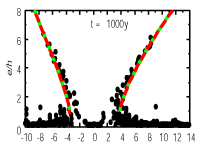 evolution of an interior structure of a gas giant planet
evolution of an interior structure of a gas giant planetevolution of an interior structure of Jupiter with the Heneyey Method Formation of Gas Giants The accretion of planetesimals on a gas giant with 3-body simulation
right figure: Evolution of planetesimal orbits due to protoplanet grouth * Protoplanetary Disks 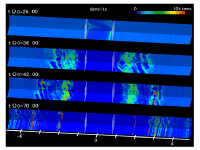 Evolution of snow line in the protoplanetary disk
Evolution of snow line in the protoplanetary disksimulation of a migration of the snow line using radiation transfer equations Photoevapolation in the protoplanetary disk The photoevapolation due to EUV from the Sun and the formation of a gap Dust falling and accretion affected by turbulence in a magnetic field MRI instability and dust accretion affected by turbulence in a magnetic field
The right figure shows a behavior of dust in MRI instability [contour:dust density] * Extrasolar Planets 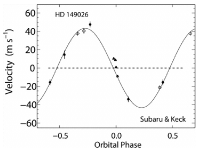 Observation of extrasolar planets with Doppler method and Transit method
Observation of extrasolar planets with Doppler method and Transit methodDetection and Observation of extrasolar planets with Doppler method and Transit method Extrasolar Planets Formation Planetary Formation by Jumping Jupiter model Gas Giants in an Extrasolar System Formation of extrasolar gas giants with large cores due to giant impacts The left figure shows radial velocity changes of HD149026b, which has a large core inside. (Sato et al., ApJ, 2007) |
 |